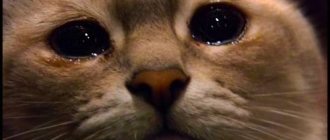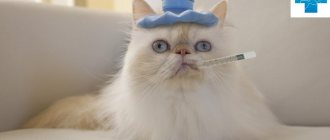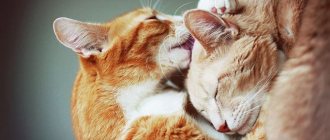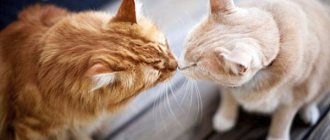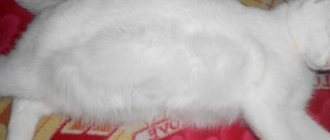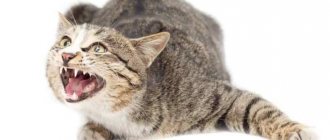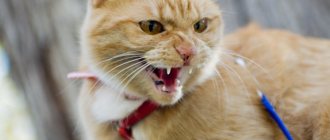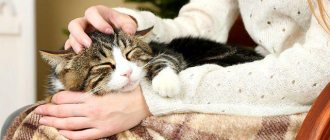Sometimes it happens that a pet dies suddenly, for example, in its sleep. Owners are surprised how it can happen that an apparently healthy cat or dog suddenly goes to the rainbow...
Recently, a reader contacted the editors of the Murkotiki website, whose young Scottish cat died during the night. She is looking for a reason that only a pathologist can find. We asked Dmitry Mitrushkin, a pathologist at the Biocontrol veterinary clinic, Candidate of Biological Sciences, for a comment on the possible causes of the sudden death of a cat or dog.
Article continues after advertisement
Among the main causes of sudden death for the owners, doctors highlight the following:
- poisoning;
- heart attack;
- stroke;
- pneumothorax;
- tracheal collapse;
- gastric volvulus;
- internal bleeding;
- heatstroke;
- foreign body in the gastrointestinal tract;
- and others.
Foreign body in the gastrointestinal tract
Cats and dogs often eat inedible objects or bones. If the bone is not thermally treated, it can no longer be digested in the gastrointestinal tract of dogs and cats. In addition, tubular bones, passing through the esophagus, injure it and can cause bleeding. Eventually the bone or foreign object ends up in the stomach or intestines and can cause a blockage and internal bleeding. The owner does not always see the problem immediately: a cat or dog that has eaten an inedible object can live for a couple of days as if nothing had happened. And then peritonitis, bleeding, necrosis of the mucous membrane and other conditions that quickly lead to death quickly develop.
You can read more about the causes of sudden death on the website of the Biocontrol clinic by following the link from this article.
Rate and share!
What to do if the cat died at home
If your pet behaves unnaturally and wants to go outside, let him go. He doesn't necessarily want to run away to die; it's quite possible he'll return renewed and full of strength. It often happens that after throwing off negativity, an animal returns renewed, which is why they say that a cat has 9 lives.
If you come home and find your cat dead, be sure to bury it. Taking a new cat home for at least three months is highly discouraged.
If an animal has died of old age, you should not carry out home cleansing procedures, but if the animal’s death occurs unexpectedly, analyze the situation and if you find any problems, it is better to contact the church.
Finally, you should remember that having a kitten at home is extremely useful, it neutralizes negativity and indicates problems at home. The death of a cat indicates possible negativity and problems at home.
Infectious diseases
The main causative agents of infections are bacteria and viruses. The pathologies they cause are highly contagious. In crowded conditions, it is recommended that not only the infected person be tested, but also the others. Most likely, they are already sick, so everyone will have to be treated together.
Panleukopenia (distemper)
Infection with distemper is accompanied by weakness, apathy, trembling of the limbs and matting of the fur. Sick animals do not respond to their mother and refuse not only feeding, but also water.
Over time, the symptoms are complemented by loose, foul-smelling stool streaked with blood and yellowish foamy vomit.
Death from dehydration occurs within 3 days, so it is very important to consult a doctor at the first behavioral changes
Why does the kitten eat poorly?
Lack of appetite in an animal can be caused by several factors:
- Stress. If, when moving, the kitten does not play, looks lethargic, does not drink and practically does not touch food, most likely it is difficult for him to adapt to his new home. Usually, getting used to the changed conditions lasts 2-3 days. Family members should provide maximum comfort to the pet and eliminate all sources of fear. The bowl of food should be placed in the far corner so that the baby can approach it without fear. Young age. It happens that breeders sell kittens when they are very tiny, when they have not yet learned to eat. In this case, the baby needs to be fed from a pipette or bottle with a cat's milk replacer until he begins to feed from a bowl on his own. Cow and goat milk is not suitable for feeding - it is too fatty for the baby’s intestines. For older pets, you can lubricate their mouths with milk to stimulate their appetite. Lack of attention. If a cat's owners don't play with it much, the cat feels lonely, sad, and doesn't eat well. Intensive feeding. If family members overfeed the kitten, it may protest or try to eat less. Inappropriate diet. Dry cat food is strictly prohibited for small kittens; special canned food is allowed. Older pets can be given meat, cereals, dairy products and boiled fish. Uncleanliness. Cats can sense if food has gone bad or if the bowl smells like detergent. It is not recommended to use chemicals when washing dishes - for a better effect, you can pour boiled water over the bowl. The feeding area should also always remain clean.
https://youtube.com/watch?v=3cvFC1E5Tk4
https://youtube.com/watch?v=3cvFC1E5Tk4
REASONS FOR THE DEVELOPMENT OF PAROXYSMAL VENTRICULAR TACHYCARDIA
Reasons for the development of PVT:
1. severe diseases of the cardiovascular system:
- myocardial infarction
- cardiomyopathy
- heart defects
- heart failure
- myocarditis (severe)
2. toxic factors:
- frequent alcohol consumption in significant quantities
- inhalation of glue fumes
- narcotic substances
3. cardiac injury
4. medications: cardiac glycosides, antidepressants, flecainide, fluoroquinolones
5. congenital anomalies of the cardiac conduction system (Brugada syndrome)
6. idiopathic VT – the cause of development is unclear
MECHANISMS OF DEVELOPMENT OF PAROXYSMAL VENTRICULAR TACHYCARDIA
Why does a patient's heart stop during PVT?
The mechanism of development of this cardiac arrhythmia is as follows. Due to the damaging factor, foci of damage appear in the myocardium (heart muscle), similar to microinfarctions, changing the overall “electrical background” of the heart.
In this regard, around such foci or in them themselves there are paroxysms of ventricular tachycardia. They cause the heart to beat at a high frequency and the main source of this arrhythmia is in the myocardium of the ventricles of the heart. Unlike the atria, the ventricles are “designed” to work at a frequency of 60-80-100 per minute. With VT, the heart rate exceeds 200 per minute and the heart, of course, cannot work in this mode for a long time. And then it stops. This is sudden cardiac death.
Such a patient can be saved by a timely applied current discharge to the chest through a defibrillator. Many countries around the world have launched a program to prevent sudden cardiac death and train the population in first aid, including in case of sudden cardiac arrest. Unfortunately, in our country only medical workers are skilled in this manipulation.
How to Prepare for Your Cat to Die Soon
The average lifespan of cats is from 10 to 15 years, although there are cases of longevity up to 28-30 years. The fact that the pet will soon go to another world is indicated by its behavior. The cat tries to retire, sits under the sofa or under the closet, eats very little food. His gaze becomes dull, his fur loses its silkiness. If the veterinarian said that everything is fine with the pet’s health, but age is making itself felt, then you should prepare for the worst.
In addition, the death of the animal is inevitable in the following cases:
- serious illness with a poor prognosis;
- a pet receiving a life-threatening injury when a decision has to be made about euthanasia.
You need to prepare for the fact that the cat will die, say goodbye to it. There is no universal method, but those who understand that their pet has very little time left are a little luckier than those who suddenly lose their pet. They can say goodbye to him
Cats feel the love of their owner, so it is very important for them to understand that they were loved until their last breath. That's why the owner is required to be nearby at all times
Loss of activity and poor appetite are signs that your cat may soon die.
TREATMENT OF PAROXYSMAL VENTRICULAR TACHYCARDIA
If VT develops, emergency hospitalization and immediate restoration of sinus rhythm are necessary.
The rhythm is restored either with medication or by
electropulse therapy (EPT)
.
An antiarrhythmic drug (amiodarone (cordarone)) is administered intravenously. Then, to prevent the re-development of arrhythmia, the patient takes this drug in monotherapy or with other drugs.
EIT uses a current discharge through the chest. The patient is put into medicated sleep, then defibrillator electrodes are applied and a shock is applied. This method is based on the fact that the basis for the development of PVT is the electrical instability of the myocardium.
The current discharge produces a kind of “shake-up” of the myocardium, suppressing “unauthorized” sources of arrhythmia. After EIT, also to prevent relapse (re-development) of arrhythmia, the patient takes antiarrhythmic drugs.
of implantable cardioverter-defibrillators (ICDs) is based on the principle of EIT.
with PVT.
A small device resembling a pacemaker is implanted under the skin, and electrodes from it “descend” into the heart through the blood vessels. If there is no arrhythmia, then this device is “silent”. If a paroxysm of ventricular tachycardia develops, the ICD is triggered and delivers a current discharge to the heart, thereby suppressing the source of the arrhythmia. Thanks to the ICD, the patient is protected from the risk of sudden cardiac arrest and, in fact, carries a small defibrillator with him at all times. The implantation of these devices is carried out by cardiovascular surgeons in specialized arrhythmology centers, which include the New Hospital.
ICD implantation does not require anesthesia; it is performed through a small incision in the skin; the patient can engage in normal activities the very next day after surgery. However, after ICD implantation, the patient must be under the supervision of a cardiac surgeon-arrhythmologist, and such supervision is also available in our clinic.
Paroxysmal ventricular tachycardia can be unstable, i.e. short-term, and go away on its own. But observation and treatment are required, since there is a risk of its re-development and threat to the patient’s life.
Sometimes cardiac surgeons resort to ablation of PVT foci, that is, they “cauterize” the arrhythmogenic focus using cold exposure (cryodestruction) or laser. These manipulations are also performed in cardiac surgery hospitals. And further observation and treatment is required under the guidance of a cardiac surgeon-arrhythmologist.
A special type of VT is paroxysms of this rhythm disorder against the background of congenital anomalies of the conduction system of the heart (for example, with Brugada syndrome). Cardiac conduction system (CCS)
- “electrical wiring” in the heart that converts an electrical impulse into myocardial contraction. With Brugada syndrome, the patient is born “prepared” to develop life-threatening arrhythmias, incl. PVT.
The “wiring” in such patients “sparks.” This is a paroxysm of arrhythmia
. Before exposure to a provoking factor (for example, taking medication), the patient is healthy, but in the event of contact with this factor, the preparation for arrhythmia is realized and it develops. Often the first and last time in my life.
Therefore, cardiologists and arrhythmologists pay such attention to family history. In the presence of congenital anomalies of PSS, the fact of death at a young age from unknown causes of one of the relatives, especially the first or second degree of kinship, is alarming.
The presence of an electrocardiogram (ECG) taken at a speed of 50 mm/sec is a mandatory part of any consultation with a cardiologist and arrhythmologist. Already when analyzing a regular ECG, the doctor recognizes the signs of Brugada syndrome and helps his patient in a timely manner.
SYMPTOMS OF PAROXYSMAL VENTRICULAR TACHYCARDIA AND FIRST AID
If circulatory arrest develops in such patients, resuscitation measures must be started immediately and carried out until doctors arrive. The only effective way to interrupt this arrhythmia is defibrillation
(that is, the application of electric current by a special defibrillator device). But while waiting for the resuscitation team, everyone should be able to help such patients.
Clinically, PVT is manifested by a sudden loss of consciousness and circulatory arrest, that is, such patients do not breathe, they have no pulse and consciousness. In this situation, you must immediately punch the patient's sternum (the narrow, flat bone in the center of the chest) and begin chest compressions (CCM).
.
How is NMS performed:
- the patient should lie on a hard surface
- the person providing assistance intensively presses on the patient’s chest with a frequency of 100 compressions per minute and to a depth of 5-6 cm
- resuscitation is carried out until the arrival of the medical team
Indirect cardiac massage performs the function of a pump and the hands of the resuscitator, in essence, replace the patient’s stopped heart.
Often paroxysms of VT are manifested by recurrent (that is, repeated) fainting, with spontaneous (that is, independent) restoration of consciousness.
